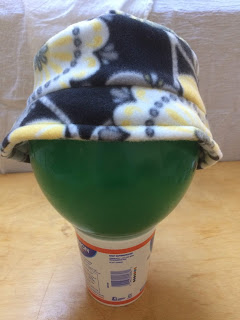I like hats.
In the summer, I usually choose a woven straw gardening hat. I like the fact that the weave doesn't completely block my upward vision. I prefer a hat with a smallish brim--large enough to partially shade my face (and especially my nose), but not so large that it gets in the way.
In winter, I want a warm hat. I used to walk outside more in winter, so my favorite hat was the kind that is woolly or fleecy with earflaps. It looked all right and it kept my ears warm. But several years ago I found a fleece hat with a brim that I really liked, and I have been wearing that instead except when the weather is very cold.
 |
| My favorite winter hat. |
|
|
It has a matching fleece "flower" and can be worn with the brim tilted up or down. With the brim down, it rather resembles a cloche.
 |
| My favorite winter hat, cloche style. |
I thought I would try to duplicate the hat in different colors of fleece. It is composed of two layers for the brim, two layers for the sides, and one layer for the top. I measured it carefully and found some yellow fleece left over from a previous project. As I tried to work out the size of the brim, it occurred to me that perhaps the makers of the hat tried to save on fabric by cutting one of the brim pieces right around the circular top piece. I decided to try making the curve of the brim not much different from the top. I didn't have the sewing machine out right then, so I mostly basted it together by hand. After all, I didn't know if it would actually fit.
 |
| Too big. |
It wasn't quite what I was after. Clearly 1/2" seam allowance was much too bulky, and I didn't want the brim to be quite so horizontal after all. But it wasn't bad. So I took my careful measurements, did a lot of calculations to figure out how I could get an interior curve of so many inches and an exterior curve of so many other inches. Solving equations with two variables came into play.
Not content with changing one part of the pattern (and the seam allowances), I tried to make the top a bit smaller in the hope of making it look rounder. I also tried using black satin as the inner side piece, with the thought that it would slide on and off nicely.
 |
| Too small. |
 |
| Maybe better this worn this way, but still too small. |
Nope. The crown looked (and felt!) noticeably too small, and the brim was almost vertical. There is a nice style of hat with such a turned-up brim, but it wasn't the style I was after.
Also, I discovered that the second layer of fleece on the sides helps give the hat structure. If I ever use a thinner fabric for the inside, I should add some interfacing to give it a bit more stiffness.
So eventually, some weeks later, I decided to try again. The first hat was too big (and horizontal) and the second was too small (and vertical). Surely something in between would be just right!
I drew a different curve for the brim somewhere in between the first two and used the larger pieces for sides and top.
 |
| The pieces of the pattern. |
 |
| The third try. |
Was it just right?
Nope.
The brim was still much too horizontal, and, in part because of the narrower seam allowances, the sides were way too tall and the top too large.
What are the take-home messages here? First, it is hard to accurately measure a fleece hat. Second, seemingly small changes can have significant effects... and yet, other changes make surprisingly less difference than one might expect. (Fleece is very stretchy.) Third, a walking foot is a fantastic thing to have when sewing fleece by machine.
I have quite a lot of lime green fleece that my daughter was going to use for a project years ago. After I've had time to recover from my pink-hat disappointment, there will likely be a hat #4 in lime green. Who knows, maybe that one will be Just Right.
Till next post.













